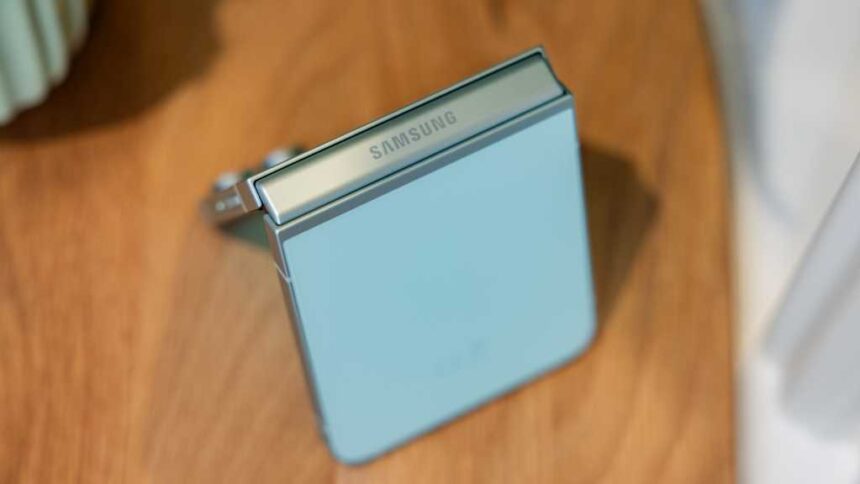Camera
Android Headlines suggests that the Galaxy Z Flip 7 will feature a triple-camera setup on the rear, with a primary wide-angle lens, an ultra-wide lens, and a telephoto lens. This would be a step up from the dual-camera setup on the Z Flip 6.
It’s not clear if Samsung will introduce any camera improvements beyond adding an extra lens.
Battery
Rumours suggest that the Galaxy Z Flip 7 will feature a 3,700 mAh battery, a slight upgrade from the 3,300 mAh battery in the Z Flip 6. With the more power-efficient Snapdragon 8 Elite chipset or Exynos 2500, this should provide better battery life overall.
Support for 25W fast charging is expected to continue, though there’s no word on any potential improvements to wireless charging speeds.
Other Features
According to SamMobile, the Galaxy Z Flip 7 may feature an under-display fingerprint sensor, similar to the Z Fold 3. This would be a welcome addition, improving security and convenience for users.
It’s also likely that the phone will support 5G connectivity, as well as features like Samsung Pay, Samsung DeX, and Bixby.
Conclusion
While the Samsung Galaxy Z Flip 7 is still months away from release, the rumours and leaks suggest that it will build upon the strengths of its predecessors while introducing some key improvements in design, display, performance, and features.
With a potential release date in mid-2025, Samsung fans and tech enthusiasts alike will be eagerly awaiting more information about this highly anticipated foldable phone.
Stay tuned for updates as we learn more about the Samsung Galaxy Z Flip 7!
Samsung is rumored to be working on the Galaxy Z Flip 7, with projected sales of 900,000 units. This aligns with reports that the Galaxy S25 series will use the Snapdragon 8 Elite chipset, possibly reserving the top-tier Exynos chipset for foldable devices.
The Galaxy Z Flip 7 is expected to come with 12GB of RAM and storage options of 256GB, 512GB, or 1TB. One of the most exciting rumors surrounding the device is the addition of a third rear camera, possibly a telephoto lens. This would be a significant upgrade from the previous models, which only featured wide and ultrawide cameras. However, some reports suggest that the primary 50MP and 12MP ultrawide cameras will remain, with no mention of a telephoto lens.
The device is likely to feature a 4000mAh battery with 25W fast charging, similar to the Z Flip 6. The integration of PHOLED technology could reduce power consumption, leading to longer battery life despite the compact form factor.
When it comes to software, the Galaxy Z Flip 7 is expected to run on Android 15 with Samsung’s One UI 7. Leaks suggest that One UI 7 will bring a redesigned user interface with new icons, animations, and improved multitasking capabilities tailored for foldable devices.
As more information becomes available, it will be interesting to see how the Galaxy Z Flip 7 stacks up against the competition. Stay tuned for updates on this highly anticipated device. The COVID-19 pandemic has brought about significant changes in the way we live, work, and interact with one another. From remote working to social distancing measures, our daily routines have been dramatically altered in response to the global health crisis. One of the most noticeable changes has been the shift towards online shopping and e-commerce.
With brick-and-mortar stores forced to close their doors or operate at limited capacity, consumers have turned to online shopping as a convenient and safe way to purchase goods and services. This surge in e-commerce has not only helped businesses stay afloat during these challenging times but has also transformed the way we shop for goods and services.
One of the key advantages of online shopping is the convenience it offers. With just a few clicks, consumers can browse through a wide range of products, compare prices, read reviews, and make a purchase without ever leaving the comfort of their homes. This convenience has become even more crucial during the pandemic, as people are hesitant to venture out to crowded shopping malls and stores.
Another benefit of online shopping is the access to a wider selection of products. With online retailers offering a vast array of products from around the world, consumers can find exactly what they are looking for, whether it’s a rare collectible item or a specific brand of clothing. This level of choice and variety is often not available in traditional brick-and-mortar stores.
Moreover, online shopping offers a safer alternative to in-person shopping, especially for those who are at higher risk of contracting the virus. By avoiding crowded spaces and minimizing physical contact with others, online shoppers can reduce their risk of exposure to COVID-19 while still being able to purchase the goods and services they need.
Despite the numerous benefits of online shopping, there are also some drawbacks to consider. One of the main challenges is the lack of physical interaction with products before making a purchase. While online retailers often provide detailed product descriptions and images, some consumers may still prefer to see and touch products in person before buying them.
Additionally, there is the issue of shipping delays and potential returns. With the surge in online shopping during the pandemic, delivery services have been overwhelmed, leading to longer shipping times and delays in receiving orders. This can be frustrating for consumers who are used to instant gratification when shopping in-store.
In conclusion, the COVID-19 pandemic has accelerated the shift towards online shopping and e-commerce, changing the way we shop for goods and services. While online shopping offers convenience, a wide selection of products, and a safer alternative to in-person shopping, there are also challenges such as the lack of physical interaction with products and shipping delays to consider. As we navigate through these uncertain times, it is essential for consumers to weigh the pros and cons of online shopping and make informed decisions about how they choose to shop.








